The Corsair H150i Elite Capellix AIO Cooler Review: Go Big Or Go Home
by E. Fylladitakis on October 15, 2020 9:30 AM EST- Posted in
- Cases/Cooling/PSUs
- Corsair
- Water Cooling
- Liquid Cooling
- RGB
- iCUE
Testing Results, Maximum Fan Speed
As always, we'll start things off by testing things at full speed/performance. Our maximum speed testing is performed with both the fans and the pump powered via a 12V DC source. This input voltage should have the pump and fans matching the speed ratings of the manufacturer. According to Corsair’s specifications, the MagLev fans included with the H150i Elite Capellix should have a rotational speed of 2400 RPM. Our tachometer indicated that the fans were rotating at an average speed of 2370 RPM, very close to their rated specifications.
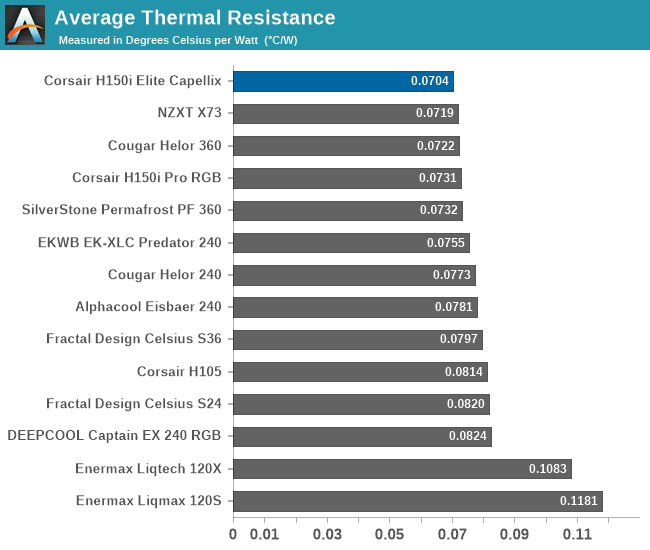

| Core Temperature, Constant Thermal Load (Max Fan Speed) |
The Corsair H150i Elite Capellix seems to be getting the best thermal performance out of every similarly sized AIO cooler that we have tested to this date, outperforming NZXT’s X73 by a whisker. The performance seems to be fairly stable across most of the load range, offering predictable performance regarding of the load, with the exception of very low loads where the temperature difference is far too small for appropriate heat transfer between the mediums.
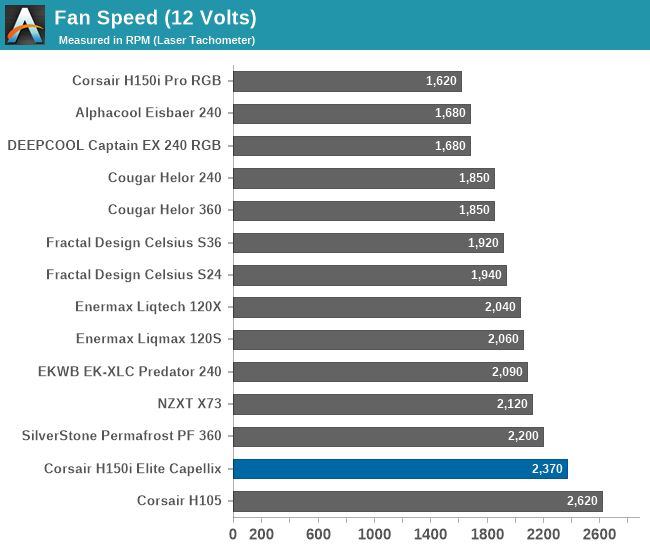
The average thermal resistance of 0.0704 °C/W is impressive but users need to keep in mind that this performance comes with the fans rotating at their maximum speed. With the powerful fans of the H150i Elite Capellix, this results to a sound pressure level of 43 dB(A), a relatively high figure for a CPU cooler.
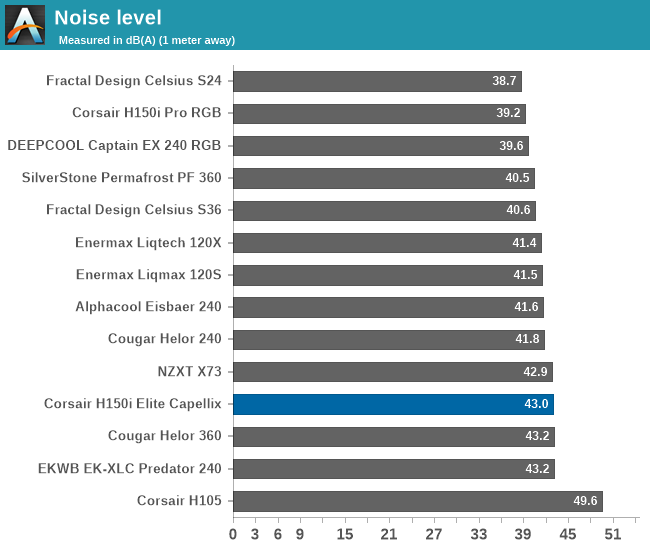
Testing Results, Low Fan Speed
Using a PWM voltage regulator, we reduced the speed of the fans manually down to half their rated speed. At this setting, the 120 mm MagLev fans of the H150i Elite Capellix rotate at 1220 RPM. Since the pump’s speed cannot be controlled directly, we had the Commander CORE module attached to a PC and set the pump to operate in its “Quiet” mode while testing.
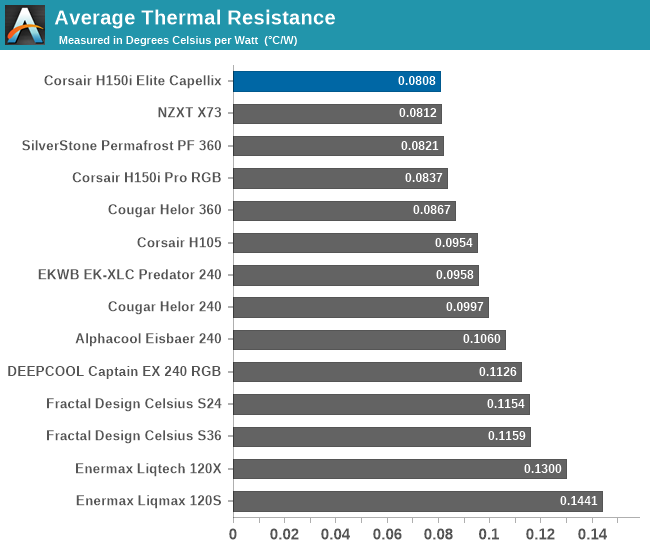

| Core Temperature, Constant Thermal Load (Low Fan Speed) |
When it comes to thermal resistance, Corsair’s latest AIO cooler initially seems to be slightly outperforming all of the 360 mm coolers that we have tested to this date. The average thermal resistance of 0.0808 °C/W is almost identical to the figures we received from the recently released NZXT X73, with Corsair’s MagLev fans giving the H150i Elite Capellix a small advantage in terms of acoustics.
But if one looks at just the thermal performance charts, other implementations with significantly slower fans, including Corsair’s older H150i Pro RGB, initially seem to be performing slightly worse. A closer look reveals that the better thermal performance is due to the quick fans of the H150i Elite Capellix, resulting to significantly higher noise levels. Setting the fans to operate even slower is likely to neutralize any thermal performance advantage that the cooler has.

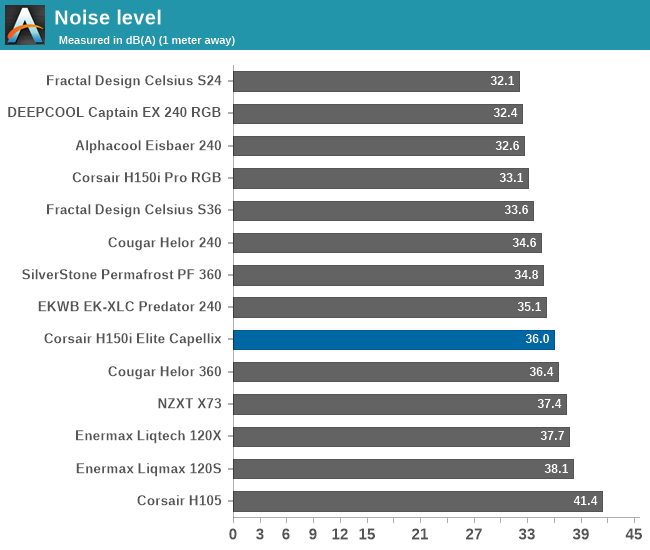
Thermal Resistance VS Sound Pressure Level
During our thermal resistance vs. sound pressure level test, we maintain a steady 100W thermal load and assess the overall performance of the coolers by taking multiple temperature and sound pressure level readings within the operating range of the stock cooling fans. The result is a graph that depicts the absolute thermal resistance of the cooler in comparison to the noise generated. For both the sound pressure level and absolute thermal resistance readings, lower figures are better.
This graph reveals interesting information regarding the overall performance of the H150i Elite Capellix. Although it does manage to get the best thermal performance out of every other similarly sized cooler, it can be seen that the older H150i Pro RGB actually outperforms it when taking the acoustics into account. This is because of the fast 2400 RPM fans that Corsair includes with the H150i Elite Capellix and our two-point testing methodology. Theoretically, the H150i Elite Capellix would perform identically or nearly identically with the H150i Pro RGB if both coolers were to share the same fans. It is also proof that the long and thin 360 mm radiator benefits very little from higher airflow, as its heat transfer surface is far too large to allow for significant temperature differences even if the airflow is low.


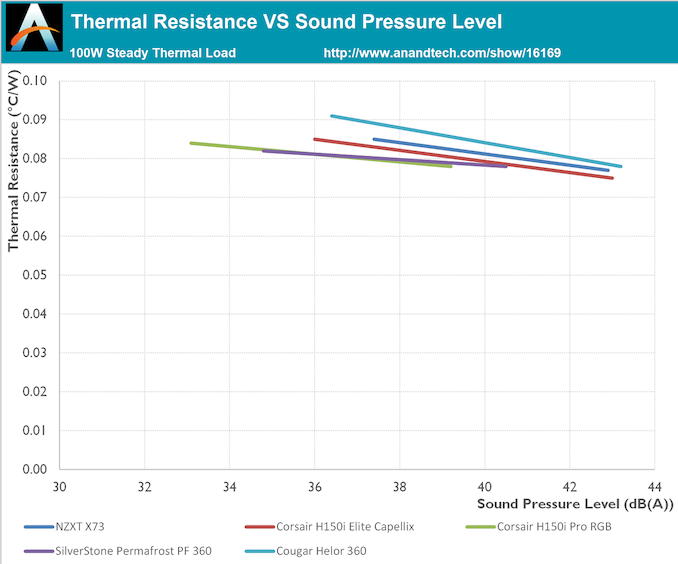








37 Comments
View All Comments
bigi - Thursday, October 15, 2020 - link
Shiat is getting ridiculous. I miss the days where computer parts did not emit light, blinks, and weren't designed for 12 year olds.khanikun - Thursday, October 15, 2020 - link
Why you can buy parts from other companies that don't do that. There's nothing wrong with having lots of options. I would like companies to have 3 options for these kind of things. No fans, has fans, and has RGB fans. Course I don't think any AIO manufacturers sell them without fans.ANoNameX - Monday, October 19, 2020 - link
@ Ian Cutress - it would be great to know if the base plate would cover the heat spreader of an sTRX4 Threadripper. It's basically the #1 concern for AIO coolers with Zen2 Threadrippers.BattleRam - Thursday, October 22, 2020 - link
Cmon no comparison to a Noctua D15 ? I know it is not an water cooler but I wish we could know exactly how much better than the best aircooler this new Corsair is.Tom Sunday - Sunday, November 1, 2020 - link
I always grow suspicious when companies use the word ELITE. But CAPELLIX what a nice new word thrown into the AIO market basket! Looks like Corsair's AIO dominance continues with all of its LED splendor (or circus action) still trying to making the big $$$ and profits. For sure the "cool Capellix'' price of $190 is not for the average blue collar Joe like me working midnights riding the forklift. But now Intel with especially the "heat on by AMD" will be pushing out their 12th Generation (10nm-Fin) Alder Lake program probably just before the 2021 Holidays? The Big Deal: The socket dimensions for the newly Alder Lake mandated LGA-1700 is about 7.5mm taller than Intel's current LGA 1200 socket and this forcing that all future mobo architectures will be dramatically changing along with their graduation to DDR5 and much more. Meaning that the H150i Capellix (along with all their other competing AIO siblings) will essentially be obsolete by the end of next year since the current chipset AIO water blocks will not fit the new CPU molds. This of course will first only be applying to system upgraders, but nevertheless and with AIO's supposed to be lasting 5-years or so, it will most certainly make people think twice before investing in a new or upgraded (costly) AIO in the months to come? I am curious in how the industry or sellers will handle this matter? Or will it be just for the enthusiast or those havng money to burn to simply starting over and or further supporting the seemingly neverending AIO upgrade craze? Unless of course we are ready now to create a used AIO market like the existing and booming 'used GPU's now being proffered. Would you buy a used Capellix? Thoughts?Damorejordane - Wednesday, November 4, 2020 - link
Admittedly a super product, I can listen and download music comfortably on https://tonurideapelgratuite.com/alex31g - Friday, August 13, 2021 - link
I have a noob question. Is this one has better cooling performance than NZXT X63 RGB?